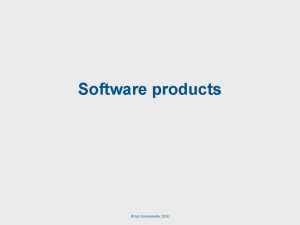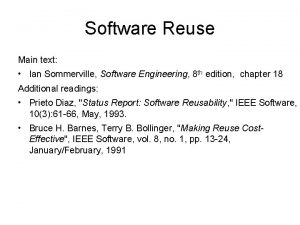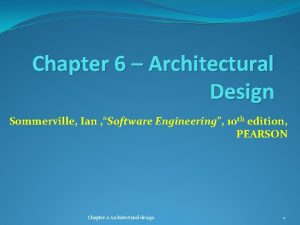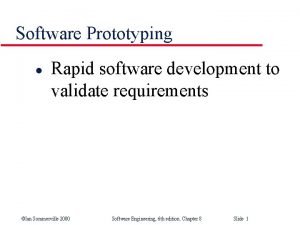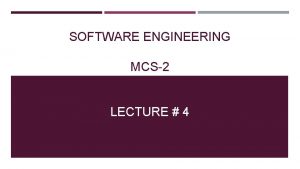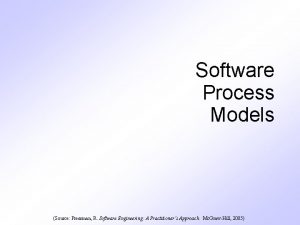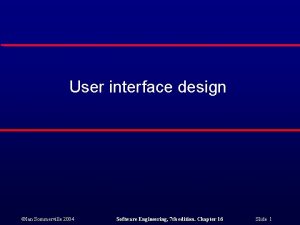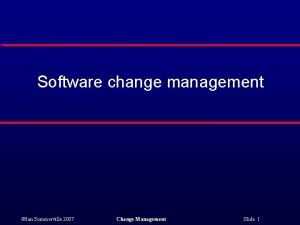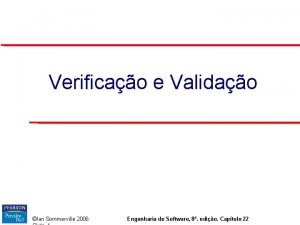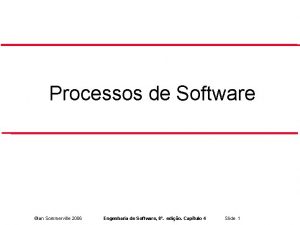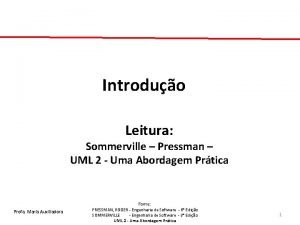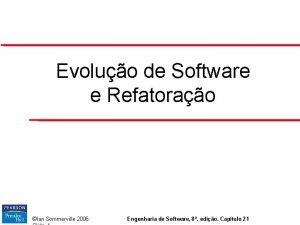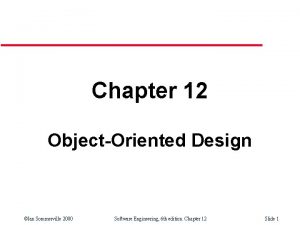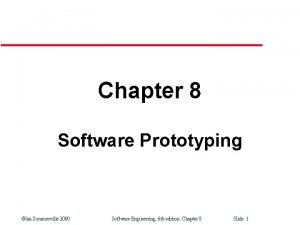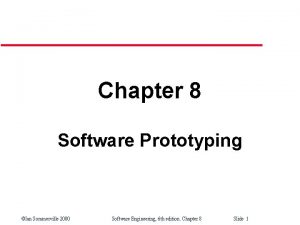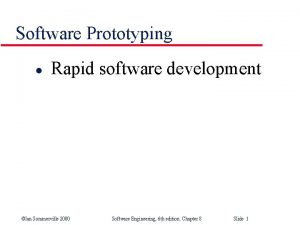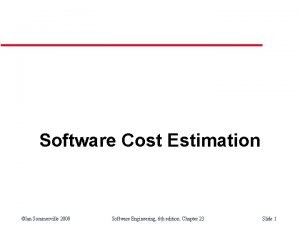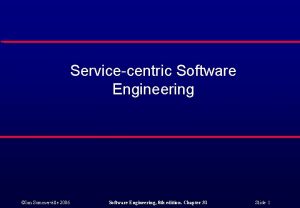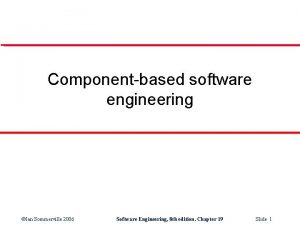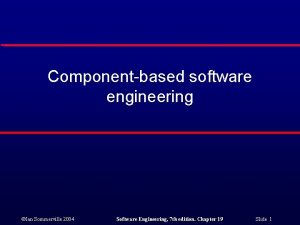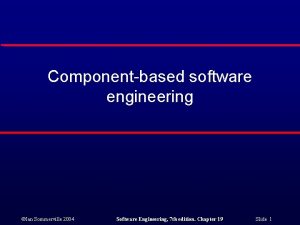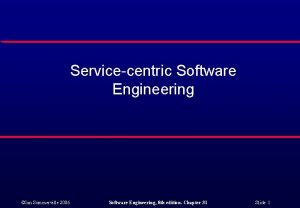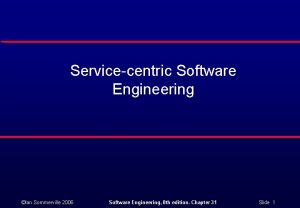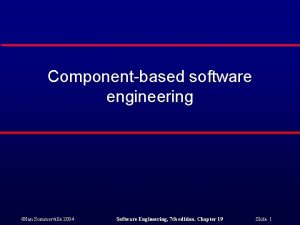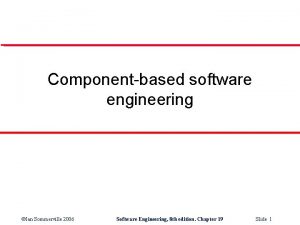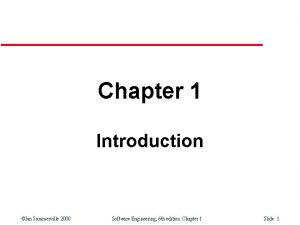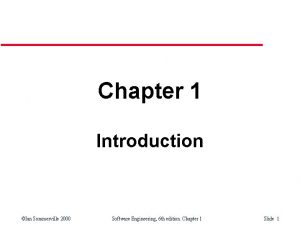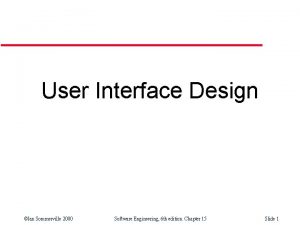Software Prototyping Ian Sommerville 2000 Software Engineering 6

















- Slides: 17

Software Prototyping ©Ian Sommerville 2000 Software Engineering, 6 th edition. Chapter 8 Slide 1

System prototyping l l l Prototyping is the rapid development of a system In the past, the prototype was normally thought of as inferior in some way to the required system, so further development was required. Now, the boundary between prototyping and normal system development is blurred and many systems are developed using an evolutionary approach. ©Ian Sommerville 2000 Software Engineering, 6 th edition. Chapter 8 Slide 2

Uses of system prototypes l The principal use is to help customers and developers understand the requirements for the system • • l Requirements elicitation. Users can experiment with a prototype to see how the system supports their work Requirements validation. The prototype can reveal errors and omissions in the requirements Prototyping can be a risk reduction activity that reduces requirements risks. ©Ian Sommerville 2000 Software Engineering, 6 th edition. Chapter 8 Slide 3

Prototyping benefits l l l Misunderstandings between software users and developers are exposed. Missing services may be detected and confusing services may be identified. A working system is available early in the process. The prototype may serve as a basis for deriving a system specification. The system can support user training and system testing. ©Ian Sommerville 2000 Software Engineering, 6 th edition. Chapter 8 Slide 4

Prototyping benefits l l l Improved system usability Closer match to the system needed Improved design quality Improved maintainability Reduced overall development effort (? ) ©Ian Sommerville 2000 Software Engineering, 6 th edition. Chapter 8 Slide 5

Prototyping in the software process l Evolutionary prototyping • l An approach to system development where an initial prototype is produced and refined through a number of stages to the final system Throw-away prototyping • A prototype which is usually a practical implementation of the system is produced to help discover requirements problems and then discarded. The system is then developed using some other development process. ©Ian Sommerville 2000 Software Engineering, 6 th edition. Chapter 8 Slide 6

Prototyping objectives l l The objective of evolutionary prototyping is to deliver a working system to end-users. The development starts with those requirements that are best understood. The objective of throw-away prototyping is to validate or derive the system requirements. The prototyping process starts with those requirements that are poorly understood. ©Ian Sommerville 2000 Software Engineering, 6 th edition. Chapter 8 Slide 7

Evolutionary prototyping l l l Good for systems where the specification cannot be developed in advance; e. g. , AI systems and user interface systems Based on techniques that allow rapid system iterations Verification is impossible as there is no specification. Validation means demonstrating the adequacy of the system. ©Ian Sommerville 2000 Software Engineering, 6 th edition. Chapter 8 Slide 8

Evolutionary prototyping ©Ian Sommerville 2000 Software Engineering, 6 th edition. Chapter 8 Slide 9

Evolutionary prototyping l l Specification, design and implementation are inter -twined. The system is developed as a series of increments that are delivered to the customer. Techniques for rapid system development are used such as CASE tools and 4 GLs. User interfaces are usually developed using a GUI development toolkit. ©Ian Sommerville 2000 Software Engineering, 6 th edition. Chapter 8 Slide 10

Evolutionary prototyping advantages l Accelerated delivery of the system • l Rapid delivery and deployment are sometimes more important than functionality or long-term software maintainability User engagement with the system • Not only is the system more likely to meet user requirements, they are more likely to commit to the use of the system ©Ian Sommerville 2000 Software Engineering, 6 th edition. Chapter 8 Slide 11

Evolutionary prototyping problems l Management problems • • l Maintenance problems • l Existing management processes assume a waterfall model of development Specialist skills are required which may not be available in all development teams Continual change tends to corrupt system structure so long-term maintenance is expensive Contractual problems ©Ian Sommerville 2000 Software Engineering, 6 th edition. Chapter 8 Slide 12

Prototypes as specifications l l l Some parts of the requirements (e. g. , safetycritical functions) may be impossible to prototype and so don’t appear in the specification. An implementation has no legal standing as a contract. Non-functional requirements cannot be adequately tested in a system prototype. ©Ian Sommerville 2000 Software Engineering, 6 th edition. Chapter 8 Slide 13

Incremental development l l System is developed and delivered in increments after establishing an overall architecture Requirements and specifications for each increment may be developed Users may experiment with delivered increments while others are being developed. Therefore, these serve as a form of prototype system. Intended to combine some of the advantages of prototyping, but with a more manageable process and better system structure ©Ian Sommerville 2000 Software Engineering, 6 th edition. Chapter 8 Slide 14

Throw-away prototyping l l l Used to reduce requirements risk The prototype is developed from an initial specification, delivered for experimentation, then discarded. The throw-away prototype should NOT be considered as a final system • • • Some system characteristics may have been left out There is no specification for long-term maintenance The system will be poorly structured and difficult to maintain ©Ian Sommerville 2000 Software Engineering, 6 th edition. Chapter 8 Slide 15

Prototype delivery l l Developers may be pressured to deliver a throwaway prototype as a final system. This is not recommended • • It may be impossible to tune the prototype to meet nonfunctional requirements. The prototype is inevitably undocumented. The system structure will be degraded through changes made during development. Normal organizational quality standards may not have been applied. ©Ian Sommerville 2000 Software Engineering, 6 th edition. Chapter 8 Slide 16

Throw-away prototyping advantages l Increase in speed of delivery of the prototype: • • • l No need to worry about documentation Can use rapid development tools that may not normally be used for final product development Can use any tool that will meet the need (the prototype will be discarded) Developers can concentrate heavily on eliciting requirements from the client rather than on actual software development. ©Ian Sommerville 2000 Software Engineering, 6 th edition. Chapter 8 Slide 17
 Engineering software products ian sommerville
Engineering software products ian sommerville Ian sommerville software engineering
Ian sommerville software engineering Inżynieria oprogramowania ian sommerville
Inżynieria oprogramowania ian sommerville Sommerville software engineering slides
Sommerville software engineering slides Rapid prototyping software development
Rapid prototyping software development Prototyping process in software engineering
Prototyping process in software engineering Incremental deployment
Incremental deployment User interface prototyping in software engineering
User interface prototyping in software engineering Change management in software testing
Change management in software testing Sommerville
Sommerville Sommerville
Sommerville Sommerville
Sommerville Uml 2 uma abordagem prática
Uml 2 uma abordagem prática Sommerville
Sommerville Sommerville
Sommerville Sommerville
Sommerville Elaine sommerville
Elaine sommerville 666 rule presentation
666 rule presentation
